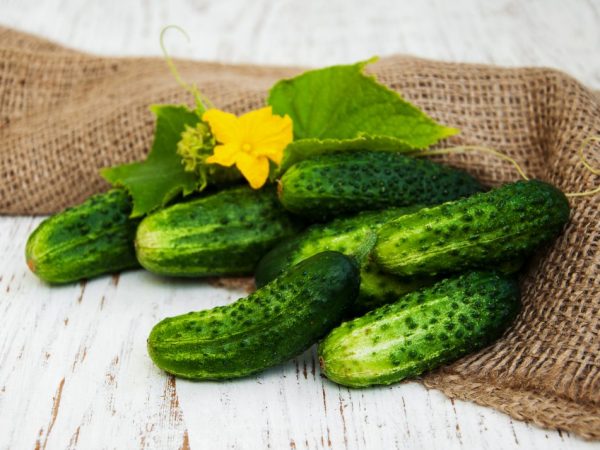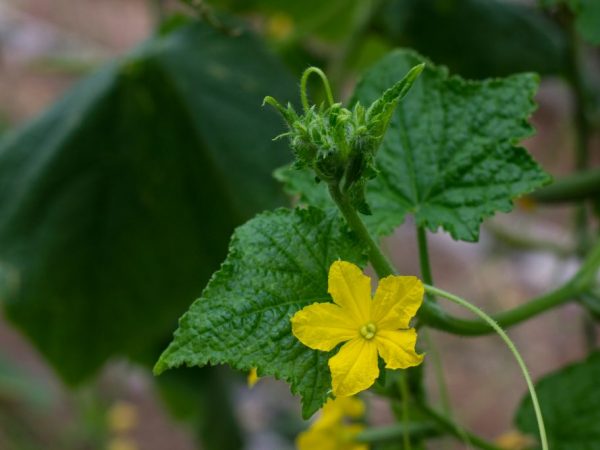Characteristics of cucumbers varieties Veselye gnomes
The yield of hybrid crops is significantly higher than that of conventional cucumbers. A vivid representative of such hybrids is the Merry Gnomes cucumber variety. Gardeners plant the hybrid under a film, in open ground, and in a greenhouse.

Characteristics of cucumbers variety Veselye Gnomiki
Description of the variety
Variety Cheerful Gnomes F1 bred by breeders as a hybrid for greenhouses and unprotected ground. The plant does not need insects for pollination.
Bush
Funny gnomes are distinguished by the bouquet-laying of the ovaries. There are up to 5 of them in each bundle. With proper care, gardeners remove up to 8 kg of cucumbers from one bush of the Merry Dwarfs.
Gnomes are early maturing varieties. The first fruits ripen 38–40 days after germination. The hybrid bears fruit until the end of August.
Fruit
F1 Gnomes are cylindrical in shape. The length of one fruit is no more than 9 cm, weight is up to 90 g. The cucumber is covered with small tubercles and white thorns. Thin greens have a juicy fragrant pulp.
Those who have already grown cucumbers of this variety note the excellent taste of the fruit. cucumbers show good keeping quality and transportability.
Planting cucumbers
For successful cultivation of bundled cucumbers, the seeds of the culture are germinated before planting. To do this, first let the seeds swell in warm water, then transfer them to a damp cloth and leave. After 2 days, most of the seeds have roots. The seeds are ready for planting.
Seedling
Recently, gardeners prefer to use the seedling method of growing cucumbers. Funny F1 gnomes are no exception.
For seedlings, seeds of cucumbers begin to be sealed in March. The soil is chosen light and loose. For fertilization, organic matter is used.
Picking
Bunch cucumbers do not like picks. To avoid unnecessary transplants, plastic cups are used to grow seedlings. Pour earth into the prepared container, lightly water it. The depth of seeding is 2-3 cm. If a box is used for growing seedlings, grooves are made and seeds are placed in them. A distance of at least 7 cm is left between the seeds. An interval of 20 cm is observed between the rows.
Seedling shelter

The future harvest depends on the quality of seedlings.
The containers are covered with cling film and left until the first shoots appear. During this time, it is important to maintain the temperature at 20 ° C. Water the seedlings sparingly: the soil should be slightly moist. You can feed the sprouts after the appearance of 2 real leaves.
Transfer to the ground
The matured seedlings of the Dwarfs are taken out to a permanent place 25-30 days after full sprouting. In the greenhouse, 2-3 plants are placed per 1 sq. m. In the open field, 4-5 sprouts are planted for each square meter.
Open ground
In unprotected soil, seeds are sown in late April and early May. The heated soil is dug up together with organic fertilizers, loosened and watered well.Manure and chicken droppings are used as fertilizers.
Sprouted seeds are placed in the holes according to the scheme 30 x 70 cm. This arrangement of the bushes contributes to good illumination of the plants and unhindered access to the bushes for irrigation and fertilization.
Seed in the greenhouse
In regions with a cold climate, cucumbers are recommended to be planted in a greenhouse. Sowing of seeds begins in the second half of April. The beds for the vegetable are preliminarily prepared. They dig up the ground in the greenhouse, remove the weeds, introduce organic matter, and then water the soil well.
For better growth, seeds are germinated, then 2 seeds are laid out in each hole. For 1 sq. m have no more than 5 holes.
Bush care
By the time of fruiting, plants should have a developed root system, formed leaves. The key to this is proper care of the culture.
Watering
Cucumbers take water gratefully. The soil in cucumber beds should not be overmoistened.
Watering rules:
- cucumbers are watered every 2-3 days;
- watering is carried out in the evening when the effect of sunlight on the plant is minimal;
- on sultry summer days; the vegetable is watered in the morning, before the onset of heat;
- avoid droplets of water falling on the foliage: this protects the plant from sunburn;
- the culture is watered with warm, settled water;
- reduce watering during cold snaps.
Top dressing

Fertilize correctly
The introduction of nutrients increases the yield of plants. Gnomes love both root and foliar feeding. When making fertilizers, you should adhere to a number of rules:
- Nutrients should not be in excess: this leads to the development of diseases, oppression of the plant.
- Foliar dressing is carried out in the evening or in cloudy weather.
- Mineral mixtures alternate with organic fertilizers.
- Top dressing is combined with watering.
First feeding
The first feeding is carried out 15 days after planting. Fertilization is repeated every 10 days, even during the fruiting period.
Organic Fertilizer Recipes:
- solution of poultry manure in a ratio of 1 to 15;
- slurry, diluted in a ratio of 1 to 8;
- 1 part horse or cow manure to 6 parts water;
- infusion of green grass, diluted with warm water in a ratio of 1: 5.
Second feeding
Mineral fertilizers are prepared according to the following schemes:
- 1 tbsp. l. urea and 60 g of superphosphate are dissolved in 10 l of water;
- urea, superphosphate and potassium salt are diluted in 10 liters of water;
- 1 glass of wood ash is insisted in 10 liters of water.
Depending on the period of development of the culture, the proportions of mineral fertilizers are changed. At the first stage of development, emphasis is placed on nitrogen, during flowering - on phosphorus, then both will be needed.
It is recommended to spray cheerful gnomes with growth stimulants that provoke the formation of ovaries in the bunch. This procedure is carried out twice a season: when the buds have just opened and during abundant flowering.
Bush formation
Funny gnomes are grown on a trellis: this allows you to achieve the most comfortable conditions for the growing season of the crop.
Don't forget to shape the bushes. In the axils of the lower four leaves, all female flowers and shoots are removed. Further, to the very top, no more than one bunch of cucumbers and 2 leaves are left in each node. When the main stem grows to a trellis, one bunch of cucumbers and 3 leaves are left at its top, and the stem is pinched.
Harvesting
For cucumbers to bear fruit longer, it is necessary to pick ripe cucumbers on time. Zelentsy is filmed every 2 days. For pickles, the fruits are harvested daily.
The overgrowth of zelents should not be allowed: this leads to the drying out of the bush.
Diseases and pests
Funny gnomes are resistant to powdery mildew, fungal diseases, all types of spotting. Preventive measures cannot be neglected - the culture should be sprayed with fungicides.
Cucumbers can be attacked by aphids. Insecticides and folk methods help in the fight against insects:
- soap solutions;
- ash solutions;
- vegetable infusions and decoctions.
Summarizing
Funny gnomes are a versatile variety. The cultivation of these cucumbers has some peculiarities, but it is not difficult. With proper care, bunch cucumbers will delight you with a good harvest.


